Suchergebnisse
Digital Urban Mining Platform: Assessing the material composition of building stocks through coupling of BIM to GIS (BIMstocks)
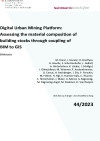
Hauptziel von BIMstocks ist die Entwicklung einer Methodik für die digitale Erfassung der materiellen Zusammensetzung des Baubestandes für die Modellierung einer digitalen Urban Mining Plattform sowie Prädiktion der Recyclingpotentiale.
Schriftenreihe
44/2023
M. Honic, I. Kovacic, D. Breitfuss, G. Gourlis, S. Schützenhofer, J. Gallistl, A. Hinterleitner, K. Löcker, I. Schlögel, I. Gilmutdinov, M. Wimmer, P. Aschenbrenner, O. Cencic, H. Rechberger, I. Erb, P. Ferschin, M. Fellner, H. Figl, V. Huemer-Kals, C. Thurner, S. Hinterholzer, J. Maier, U. Moroz, A. Ragossnig, M. Ragossnig-Angst, M. Raskovic, D. Van Rooyen
Herausgeber: BMK
Deutsch, 57 Seiten
Downloads zur Publikation
CO2-Demobau - Sondierung zur Durchführbarkeit CO2-neutraler Demonstrationsbaustellen
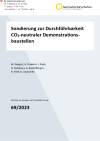
Durch Aufzeigen von grünen Innovationen, Vernetzung mit Stakeholdern der Baubranche und Anwendung der Erkenntnisse der Vorstudie "CO2 neutrale Baustelle" wird das Fundament für zukünftige CO2-neutrale Demonstrationsbaustellen gelegt. Diese Baustellen dienen als Best-Practice-Beispiele für die Bereiche Vergabe, Baubetriebsorganisation und -technologie.
Schriftenreihe
69/2023
M. Weigert, H. Daxbeck, J. Raab, N. Kisliakova, A. Bischofberger, R. Hölzl, B. Lepuschitz
Herausgeber: BMK
Deutsch, 100 Seiten
Downloads zur Publikation
Sondierung für ein Mobile Mapping Reallabor – IoT- und geoKI-gestütztes Datenmanagement für die klimaneutrale Stadt (GeoDatKlim)
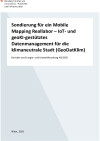
Vorbereitung eines Reallabors, das es zahlreichen Akteur:innen ermöglicht, den tatsächlichen Nutzen urbaner Daten bzw. deren KI-unterstützter Analyse für eine klimaneutrale Stadt zu beforschen. Mittels Klärung strategischer, technischer und rechtlicher Aspekte sowie im Wege von Potenzialanalysen entlang relevanter Anwendungsfälle werden die Rahmenbedingungen für eine offene, mehrjährige Forschungsumgebung (Reallabor) in Wien auf den Weg gebracht.
Schriftenreihe
49/2025
Nikolaus Summer, Christian Habernig, Martin Traunmüller
Herausgeber: BMIMI
Deutsch, 54 Seiten
Downloads zur Publikation
Entwicklung einer strukturierten und fehlerminimierten Datenaufbereitung und Dokumentation für Energieausweise (EDEN)
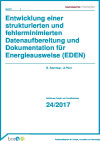
Ziel des Forschungsvorhabens war eine substantielle Behandlung der Problematik der mangelnden Reproduzierbarkeit der Resultate von Energieausweisen in der Praxis.
Schriftenreihe
24/2017
B. Sommer, U. Pont
Deutsch, 74 Seiten
Downloads zur Publikation
Messtechnische Untersuchung von energieeffizienten Demonstrationsgebäuden
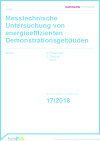
Messtechnische Untersuchung und Analyse von mindestens 10 Dienstleistungs- und Wohngebäuden in Österreich mit innovativen Technologien bzw. Gesamtkonzepten für die thermische Konditionierung und Gebäude-Energieversorgung. Die Ergebnisse dienen der Nutzung des Optimierungspotentials in energetischer, ökologischer und sozialer Hinsicht für künftige Bauvorhaben.
Schriftenreihe
17/2018
M. Beermann, E. Sauper, I. Sauer
Herausgeber: BMVIT
Deutsch, 91 Seiten
Downloads zur Publikation
Der städtische Untergrund als Rohstoffmine? Potential an Sekundärressourcen in der erdverlegten Infrastruktur
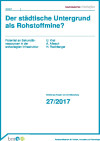
Machbarkeit eines Ressourcenkatasters zur Inventarisierung, Charakterisierung und Verortung der Materialbestände in den erdverlegten Infrastrukturnetzwerken österreichischer Stadtregionen. Das Ergebnis dient der ökonomischen Bewertung von Sekundärrohstoffpotenzialen.
Schriftenreihe
27/2017
U. Kral, A. Allesch, H. Rechberger
Deutsch, 73 Seiten
Downloads zur Publikation
Anwendung nichtlinearer Regelungstechnik und intelligenter Sensorik zur Effizienzsteigerung in Gebäuden
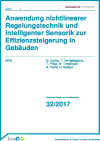
Mit modellbasierten, nichtlinearen Methoden der Regelungstechnik in Kombination mit intelligenter Sensorik, wurden im Rahmen des Projekts innovative Steuer- und Regelkonzepte für Heiz-, Kühl- und Lüftungssysteme (HKL) und Gebäudelasten entwickelt und in Gebäudemanagementsysteme implementiert.
Schriftenreihe
32/2017
G. Zucker, T. Ferhatbegovic, T. Pflügl, W. Timelthaler, B. Kodré, H. Baldauf
Herausgeber: BMVIT
Deutsch, 42 Seiten
Downloads zur Publikation
Digitale Technologien
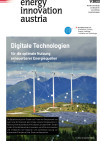
Digitale Technologien für die optimale Nutzung erneuerbarer Energiequellen.
energy innovation austria
1/2022
Herausgeber: BMK und Klima- und Energiefonds
Deutsch, 12 Seiten
Downloads zur Publikation
Bestand optimal nutzen - Sanierung energieeffizient implementieren! (BONSEI!)
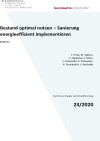
Das Projekt BONSEI! möchte eine energetisch effiziente und sozial verträgliche Nachverdichtung in städtischen Wohngebäuden in Privateigentum fördern und zugleich eine methodische Grundlage für ressourceneffizientere Stadtregionen schaffen. Die Ergebnisse fließen in die Konzeption eines neuartigen Dienstleistungsangebots ein, das als neutrale Erstberatung bei privaten Verdichtungsvorhaben dienen soll.
Schriftenreihe
23/2020
T. Prinz, W. Spitzer, S. Gadocha, S. Erber, C. Schneider, P. Schweizer, R. Fuchshofer, J. Reithofer
Herausgeber: BMK
Deutsch, 77 Seiten
Downloads zur Publikation
Prüfstand für energieeffiziente Automation und Regelung von Gebäuden
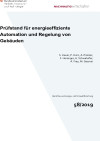
Der mit dem Planungsstand errechnete Energiebedarf deckt sich oft nicht mit den gemessenen Werten des Betriebs. In diesem Projekt werden Automation und Regelung auf den Prüfstand gestellt und eine Lösung zur Bewertung der Energieeffizienz von Regelstrategien in den Bereichen Raumlufttechnik, Betonkernaktivierung und Free Cooling entwickelt, welche anhand des Bauprojekts „Post am Rochus“ validiert wird.
Schriftenreihe
58/2019
S. Hauer, P. Horn, A. Preisler, F. Heisinger, H. Schwahofer, A. Frey, M. Gassner
Herausgeber: BMVIT
Deutsch, 29 Seiten
Downloads zur Publikation
P2PQ - Peer2Peer im Quartier
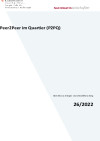
Das Projekt Peer2Peer im Quartier befasst sich mit der konkreten Umsetzung von Anwendungen zu Photovoltaik-Eigenverbrauchsoptimierung sowie Peer-to-Peer-Beziehungen auf Basis der Blockchain-Technologie in Quartieren und deren Validierung im Echtbetrieb.
Schriftenreihe
26/2022
Herausgeber: BMK
Deutsch, 43 Seiten
Downloads zur Publikation
Hotspots: Holistic thermographic screening of urban physical objects at transient scales
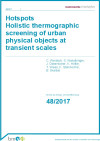
Die Projektidee verknüpft messtechnische Innovationen in der Erfassung und Generierung stadtbezogener Daten mit neuartigen Prozessketten in der Datenauswertung und Analyse. Auf Basis wissenschaftlicher Ansätze erarbeitet HOTSPOTS eine durchgängige Verfahrenskette die künftige Auswahlverfahren im Bereich von baulichen Maßnahmen der Stadtentwicklung auf eine nachvollziehbare und (mess-)datengetriebene Basis stellt, und somit das Risiko von ad-hoc Entscheidungen oder Fehlinvestitionen reduziert.
Schriftenreihe
48/2017
C. Windisch, S. Wakolbinger, J. Österreicher, K. Höfler, T. Weiss, K. Steinnocher, B. Skarbal
Herausgeber: BMVIT
Deutsch, 73 Seiten
Downloads zur Publikation
Nutzerorientierte Entwicklung von Technologien und Services für Energiegemeinschaften (NETSE)
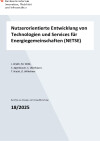
Im Projekt NETSE werden Grundlagen für die Etablierung von Erneuerbaren Energiegemeinschaften entwickelt. Dies umfassen die Ausstattung von relevanten technischen Einheiten mit geeigneten Schnittstellen, die Entwicklung einer Datenplattform für die Abwicklung von Aufgaben im Zuge des Betriebs von Energiegemeinschaften, die Entwicklung eines Tools zur Optimierung der technischen Spezifikationen sowie den Betrieb einer Energiegemeinschaft.
Schriftenreihe
18/2025
J. Walch, M. Wölk, S. Aigenbauer, C. Oberbauer, T. Nacht, D. Wilhelmer
Herausgeber: BMIMI
Deutsch, 60 Seiten
Downloads zur Publikation
Urbaner Kältebedarf in Österreich 2030/2050
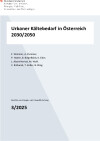
Systematische Aufarbeitung des steigenden Kühlbedarfs und Darstellung der geographischen Verortung des Kältebedarfs in Österreich. Das Ergebnis dient als Entscheidungshilfe bei der Entwicklung von Klimaschutzmaßnahmen und Klimawandelanpassungsstrategien sowie eine Abschätzung zum Kältebedarf der Zukunft.
Schriftenreihe
3/2025
F. Wimmer, A. Pummer, P. Holzer, B. Beigelböck, K. Eder, L. Abart-Heriszt, M. Wolf, C. Rzihacek, T. Keller, B. Kling
Herausgeber: BMK
Deutsch, 91 Seiten
Downloads zur Publikation
ENUMIS - Energetische Auswirkungen von Urban Manufacturing in der Stadt
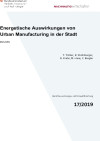
Das Projekt beleuchtet die Herausforderungen von Urban Manufacturing (UM) aus Energiesicht und zeigt Chancen auf, die sich durch eine Umsetzung von UM-Konzepten in Hinblick auf die Konzeption nachhaltiger Energiesysteme für Städte ergeben.
Schriftenreihe
17/2019
T. Tötzer, R. Stollnberger, R. Krebs, M. Haas, C. Biegler
Deutsch, 44 Seiten
Downloads zur Publikation
Häuser für Energie und RessOurcenEffiziente Siedlungen (HEROES)
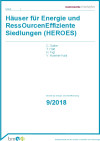
Ein vereinfachtes Verfahren für die Berechnung von ökologischen Kennzahlen für bisher nicht betrachtete Gebäudeteile (thermisch nicht relevante Bauteile und Haustechnikkomponenten) wird entwickelt. Die methodischen Grundlagen für die Berechnung der Primärenergie und der CO2-Emissionen im Betrieb und in den verbauten Materialien werden harmonisiert.
Schriftenreihe
9/2018
C. Sutter, T. Hatt, H. Figl, V. Huemer-Kals
Herausgeber: BMVIT
Deutsch, 79 Seiten
Downloads zur Publikation
Gamification als Möglichkeit für die Generierung von Daten zur energieorientierten Quartiersplanung (HotCity)
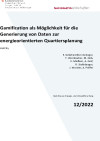
Ziel des Projekts war ein Funktionstest, ob durch Gamification kosteneffizient, rasch und zuverlässig ein aktueller Datensatz von energierelevanten Daten zur Quartiersplanung erhoben werden kann. Dies wurde am Beispiel der Potenzialermittlung von industriellen und gewerblichen Abwärmequellen in Wien und Graz ermittelt.
Schriftenreihe
12/2022
E. Gebetsroither-Geringer, T. Wernbacher, M. Göls, E. Meißner, A. Graf, R. Stollnberger, J. Worster, A. Peiffer
Herausgeber: BMK
Deutsch, 157 Seiten
Downloads zur Publikation
Building Information Modeling for Building Energy Management Systems (BIM4BEMS)
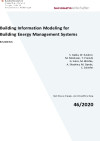
BIM4BEMS untersucht Anwendungsfälle, die den Nutzen eines BIM-Modells in Kombination mit Energiemanagementsystemen (BEMS) im Betrieb darstellen, die die Verbindung zwischen BIM und Gebäudeleittechnik (BMS) erlauben, und somit zu verbessertem Reporting und Erkennung von Ineffizienzen im bestehenden Gebäudebetrieb führen.
Schriftenreihe
46/2020
S. Gaida, W. Kastner, M. Montazer, T. Preindl, G. Suter, M. Blöchle, A. Shadrina, M. Sipetic, C. Schiefer
Herausgeber: BMK
Deutsch, 55 Seiten
Downloads zur Publikation
INN'FIT4UM - Innsbruck "Fit4UrbanMission" - klimaneutrales Innsbruck 2030
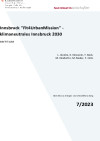
Ziel in INN’F4UM ist es, aufbauend auf einer aktuellen Darstellung der Energie- und Ressourcenflüsse gemeinsam mit der Universität Innsbruck einen Stufenplan zur Erreichung der Klimaneutralität der Stadt bis 2030 zu entwickeln.
Schriftenreihe
7/2023
L. Jänicke, K. Kleewein, Y. Back, M. Kleidorfer, M. Mailer, F. Ochs
Herausgeber: BMK
Deutsch, 39 Seiten
Downloads zur Publikation
FEELings - User Feedback for Energy Efficiency in Buildings
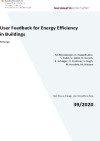
Der Energieverbrauch von Gebäuden wird maßgeblich durch das Verhalten von NutzerInnen beeinflusst. In diesem Forschungsprojekt wird ein neuartiges User-Feedbacksystem untersucht. NutzerInnen geben Feedback zur empfundenen Raumqualität. Auf Basis des Feedbacks werden Einstellungen an der Gebäudetechnik zur Energieeffizienz- und Komfortsteigerung optimiert. Der Proof-of-Concept für dieses neuartige System wird anhand von zwei Use-Cases erbracht.
Schriftenreihe
39/2020
M. Monsberger, D. Koppelhuber, S. Pabst, V. Sabol, H. Gursch, E. Schlager, O. Prentner, S. Singh, M. Herzlieb, M. Wedam
Herausgeber: BMK
Deutsch, 80 Seiten
